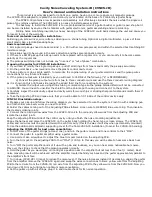
14
the sulfate ions forming a precipitate.
Pb
2+
+ SO
4.
2-
<—>
PbSO
4
(insoluble)
At the stoichiometric end point, a change in mV occurs.
Measurements may be automated by use of the Hanna
Titrator HI 901 or titrated manually.
Plot generated on Hanna HI 901 Titrator during
Plot generated on Hanna HI 901 Titrator during
Plot generated on Hanna HI 901 Titrator during
Plot generated on Hanna HI 901 Titrator during
Plot generated on Hanna HI 901 Titrator during
automated sulfate titration using HI 4112
automated sulfate titration using HI 4112
automated sulfate titration using HI 4112
automated sulfate titration using HI 4112
automated sulfate titration using HI 4112
electrode.
electrode.
electrode.
electrode.
electrode.
Notes:
•
Use of the methanol/formalin antioxidant is
advised to increase sensitivity.
•
Addition of ISA is suggested (2mL/50mL sample).
•
pH adjustment of the sample to 4-6 range is advised.
If required, use perchloric acid or sodium hydroxide.
•
The lead titrant should be 10X more concentrated
than the expected sulfate and should be standardized
against a standard sulfate solution.
Titration of Lead
A Lead electrode may be used as an indicator to follow the
progress and detect the endpoint of a chelometric titration
of lead with disodium EDTA. During the titration the sensor
follows the decreasing lead concentration as small additions
of disodium EDTA titrant are added. The EDTA reacts with
the lead forming a complex. The EDTA also can react with
a host of other metals so optimizing pH of the Pb-EDTA
complex and masking possible interferents should be
considered. Consult a comprehensive Analytical Chemistry
Treatise for techniques concerning your particular interferent.
At the end point, a larger change in mV occurs. The Hanna
Titrator, HI 901 may be used to automate this procedure.


































